A Mass Spectrometry Strategy for Protein Quantification Based on the Differential Alkylation of Cysteines Using Iodoacetamide and Acrylamide
Abstract
1. Introduction
2. Results
3. Discussion
4. Materials and Methods
4.1. Chemicals
4.2. Sample Preparation
4.3. LC-MS/MS and Data Analysis
Supplementary Materials
Author Contributions
Funding
Institutional Review Board Statement
Data Availability Statement
Conflicts of Interest
References
- Ranc, V.; Petruzziello, F.; Kretz, R.; Argandoña, E.G.; Zhang, X.; Rainer, G. Broad Characterization of Endogenous Peptides in the Tree Shrew Visual System. J. Proteom. 2012, 75, 2526–2535. [Google Scholar] [CrossRef] [PubMed][Green Version]
- Bubis, J.A.; Levitsky, L.I.; Ivanov, M.V.; Tarasova, I.A.; Gorshkov, M.V. Comparative Evaluation of Label-Free Quantification Methods for Shotgun Proteomics. Rapid Commun. Mass Spectrom. 2017, 31, 606–612. [Google Scholar] [CrossRef] [PubMed]
- Vidova, V.; Spacil, Z. A Review on Mass Spectrometry-Based Quantitative Proteomics: Targeted and Data Independent Acquisition. Anal. Chim. Acta 2017, 964, 7–23. [Google Scholar] [CrossRef] [PubMed]
- Zhao, L.; Cong, X.; Zhai, L.; Hu, H.; Xu, J.-Y.; Zhao, W.; Zhu, M.; Tan, M.; Ye, B.-C. Comparative Evaluation of Label-Free Quantification Strategies. J. Proteom. 2020, 215, 103669. [Google Scholar] [CrossRef] [PubMed]
- Goeminne, L.J.E.; Gevaert, K.; Clement, L. Experimental Design and Data-Analysis in Label-Free Quantitative LC/MS Proteomics: A Tutorial with MSqRob. J. Proteom. 2018, 171, 23–36. [Google Scholar] [CrossRef] [PubMed]
- Cozzolino, F.; Landolfi, A.; Iacobucci, I.; Monaco, V.; Caterino, M.; Celentano, S.; Zuccato, C.; Cattaneo, E.; Monti, M. New Label-Free Methods for Protein Relative Quantification Applied to the Investigation of an Animal Model of Huntington Disease. PLoS ONE 2020, 15, e0238037. [Google Scholar] [CrossRef] [PubMed]
- Schubert, O.T.; Röst, H.L.; Collins, B.C.; Rosenberger, G.; Aebersold, R. Quantitative Proteomics: Challenges and Opportunities in Basic and Applied Research. Nat. Protoc. 2017, 12, 1289–1294. [Google Scholar] [CrossRef] [PubMed]
- Qu, M.; An, B.; Shen, S.; Zhang, M.; Shen, X.; Duan, X.; Balthasar, J.P.; Qu, J. Qualitative and Quantitative Characterization of Protein Biotherapeutics with Liquid Chromatography Mass Spectrometry. Mass Spectrom. Rev. 2017, 36, 734–754. [Google Scholar] [CrossRef] [PubMed]
- Li, X. Recent Applications of Quantitative Mass Spectrometry in Biopharmaceutical Process Development and Manufacturing. J. Pharm. Biomed. Anal. 2023, 234, 115581. [Google Scholar] [CrossRef]
- Chahrour, O.; Cobice, D.; Malone, J. Stable Isotope Labelling Methods in Mass Spectrometry-Based Quantitative Proteomics. J. Pharm. Biomed. Anal. 2015, 113, 2–20. [Google Scholar] [CrossRef]
- Chen, X.; Wei, S.; Ji, Y.; Guo, X.; Yang, F. Quantitative Proteomics Using SILAC: Principles, Applications, and Developments. Proteomics 2015, 15, 3175–3192. [Google Scholar] [CrossRef] [PubMed]
- Clotet, S.; Soler, M.J.; Riera, M.; Pascual, J.; Fang, F.; Zhou, J.; Batruch, I.; Vasiliou, S.K.; Dimitromanolakis, A.; Barrios, C.; et al. Stable Isotope Labeling with Amino Acids (SILAC)-Based Proteomics of Primary Human Kidney Cells Reveals a Novel Link between Male Sex Hormones and Impaired Energy Metabolism in Diabetic Kidney Disease. Mol. Cell. Proteom. 2017, 16, 368–385. [Google Scholar] [CrossRef] [PubMed]
- Lindemann, C.; Thomanek, N.; Hundt, F.; Lerari, T.; Meyer, H.E.; Wolters, D.; Marcus, K. Strategies in Relative and Absolute Quantitative Mass Spectrometry Based Proteomics. Biol. Chem. 2017, 398, 687–699. [Google Scholar] [CrossRef] [PubMed]
- Deng, J.; Erdjument-Bromage, H.; Neubert, T.A. Quantitative Comparison of Proteomes Using SILAC. Curr. Protoc. Protein Sci. 2019, 95, e74. [Google Scholar] [CrossRef]
- Villanueva, J.; Carrascal, M.; Abian, J. Isotope Dilution Mass Spectrometry for Absolute Quantification in Proteomics: Concepts and Strategies. J. Proteom. 2014, 96, 184–199. [Google Scholar] [CrossRef]
- Shuford, C.M.; Walters, J.J.; Holland, P.M.; Sreenivasan, U.; Askari, N.; Ray, K.; Grant, R.P. Absolute Protein Quantification by Mass Spectrometry: Not as Simple as Advertised. Anal. Chem. 2017, 89, 7406–7415. [Google Scholar] [CrossRef]
- Craft, G.E.; Chen, A.; Nairn, A.C. Recent Advances in Quantitative Neuroproteomics. Methods 2013, 61, 186–218. [Google Scholar] [CrossRef]
- Moulder, R.; Bhosale, S.D.; Goodlett, D.R.; Lahesmaa, R. Analysis of the Plasma Proteome Using iTRAQ and TMT-Based Isobaric Labeling. Mass Spectrom. Rev. 2018, 37, 583–606. [Google Scholar] [CrossRef] [PubMed]
- Chen, X.; Sun, Y.; Zhang, T.; Shu, L.; Roepstorff, P.; Yang, F. Quantitative Proteomics Using Isobaric Labeling: A Practical Guide. Genom. Proteom. Bioinform. 2021, 19, 689–706. [Google Scholar] [CrossRef]
- Dowell, J.A.; Wright, L.J.; Armstrong, E.A.; Denu, J.M. Benchmarking Quantitative Performance in Label-Free Proteomics. ACS Omega 2021, 6, 2494–2504. [Google Scholar] [CrossRef]
- Pappireddi, N.; Martin, L.; Wühr, M. A Review on Quantitative Multiplexed Proteomics. ChemBioChem 2019, 20, 1210–1224. [Google Scholar] [CrossRef] [PubMed]
- Tambor, V.; Hunter, C.L.; Seymour, S.L.; Kacerovsky, M.; Stulik, J.; Lenco, J. CysTRAQ—A Combination of iTRAQ and Enrichment of Cysteinyl Peptides for Uncovering and Quantifying Hidden Proteomes. J. Proteom. 2012, 75, 857–867. [Google Scholar] [CrossRef] [PubMed]
- Chan, J.C.Y.; Zhou, L.; Chan, E.C.Y. The Isotope-Coded Affinity Tag Method for Quantitative Protein Profile Comparison and Relative Quantitation of Cysteine Redox Modifications. Curr. Protoc. Protein Sci. 2015, 82, 23.2.1–23.2.19. [Google Scholar] [CrossRef] [PubMed]
- Petriz, B.A.; Gomes, C.P.; Rocha, L.A.O.; Rezende, T.M.B.; Franco, O.L. Proteomics Applied to Exercise Physiology: A Cutting-Edge Technology. J. Cell. Physiol. 2012, 227, 885–898. [Google Scholar] [CrossRef] [PubMed]
- Jones, B.R.; Schultz, G.A.; Eckstein, J.A.; Ackermann, B.L. Surrogate Matrix and Surrogate Analyte Approaches for Definitive Quantitation of Endogenous Biomolecules. Bioanalysis 2012, 4, 2343–2356. [Google Scholar] [CrossRef] [PubMed]
- Virág, D.; Király, M.; Drahos, L.; Édes, A.E.; Gecse, K.; Bagdy, G.; Juhász, G.; Antal, I.; Klebovich, I.; Dalmadi Kiss, B.; et al. Development, Validation and Application of LC–MS/MS Method for Quantification of Amino Acids, Kynurenine and Serotonin in Human Plasma. J. Pharm. Biomed. Anal. 2020, 180, 113018. [Google Scholar] [CrossRef] [PubMed]
- Korecka, M.; Waligorska, T.; Figurski, M.; Toledo, J.B.; Arnold, S.E.; Grossman, M.; Trojanowski, J.Q.; Shaw, L.M. Qualification of a Surrogate Matrix-Based Absolute Quantification Method for Amyloid-β 42 in Human Cerebrospinal Fluid Using 2D UPLC-Tandem Mass Spectrometry. J. Alzheimer’s Dis. 2014, 41, 441–451. [Google Scholar] [CrossRef] [PubMed]
- Vinaiphat, A.; Low, J.K.; Yeoh, K.W.; Chng, W.J.; Sze, S.K. Application of Advanced Mass Spectrometry-Based Proteomics to Study Hypoxia Driven Cancer Progression. Front. Oncol. 2021, 11, 559822. [Google Scholar] [CrossRef] [PubMed]
- Heissel, S.; Frederiksen, S.J.; Bunkenborg, J.; Højrup, P. Enhanced Trypsin on a Budget: Stabilization, Purification and High-Temperature Application of Inexpensive Commercial Trypsin for Proteomics Applications. PLoS ONE 2019, 14, e0218374. [Google Scholar] [CrossRef]
- Ren, Y.; Shi, Z.; Zhang, C.; Han, Y.; Liu, S.; Hao, P. Evaluation and Minimization of Over-Alkylation in Proteomic Sample Preparation. Int. J. Mass Spectrom. 2022, 481, 116919. [Google Scholar] [CrossRef]
- Wiedemann, C.; Kumar, A.; Lang, A.; Ohlenschläger, O. Cysteines and Disulfide Bonds as Structure-Forming Units: Insights From Different Domains of Life and the Potential for Characterization by NMR. Front. Chem. 2020, 8, 280. [Google Scholar] [CrossRef] [PubMed]
- Xu, Q.A.; Madden, T.L. LC-MS in Drug Bioanalysis; Springer Science & Business Media: Berlin/Heidelberg, Germany, 2012; ISBN 978-1-4614-3828-1. [Google Scholar]
- Mant, C.T.; Burke, T.W.L.; Black, J.A.; Hodges, R.S. Effect of Peptide Chain Length on Peptide Retention Behaviour in Reversed-Phase Chromatogrphy. J. Chromatogr. A 1988, 458, 193–205. [Google Scholar] [CrossRef] [PubMed]
- Jiang, X.; Shamshurin, D.; Spicer, V.; Krokhin, O.V. The Effect of Various S-Alkylating Agents on the Chromatographic Behavior of Cysteine-Containing Peptides in Reversed-Phase Chromatography. J. Chromatogr. B Anal. Technol. Biomed. Life Sci. 2013, 915–916, 57–63. [Google Scholar] [CrossRef] [PubMed]
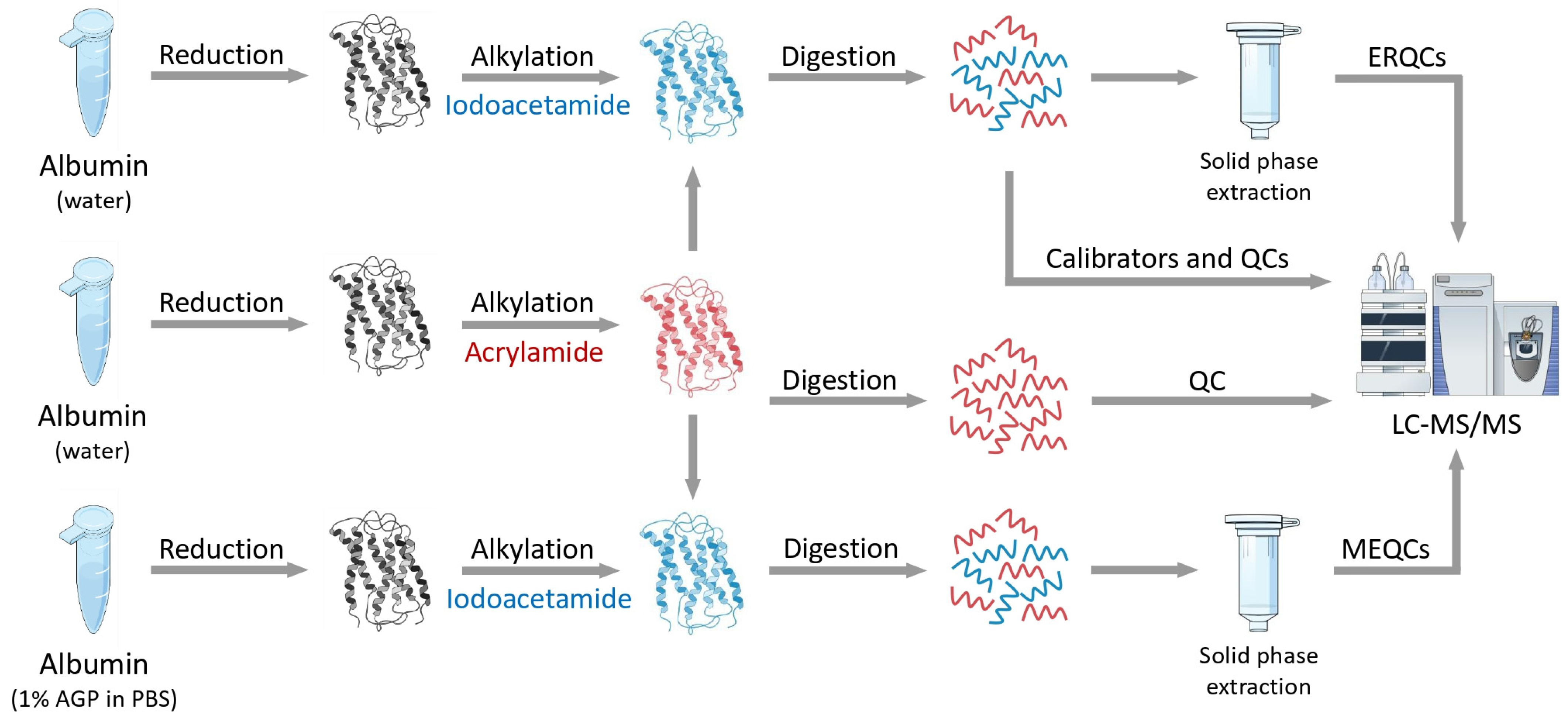
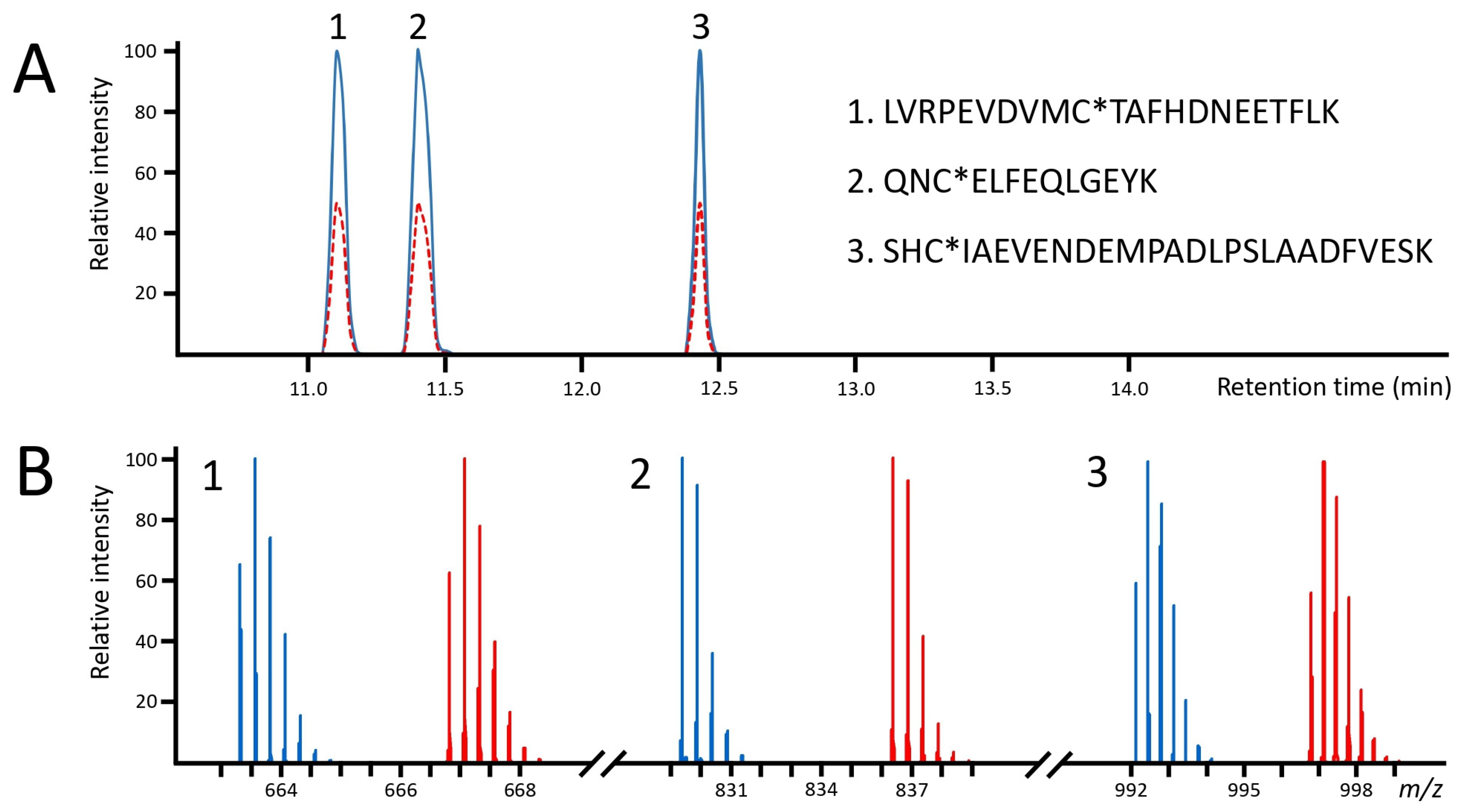
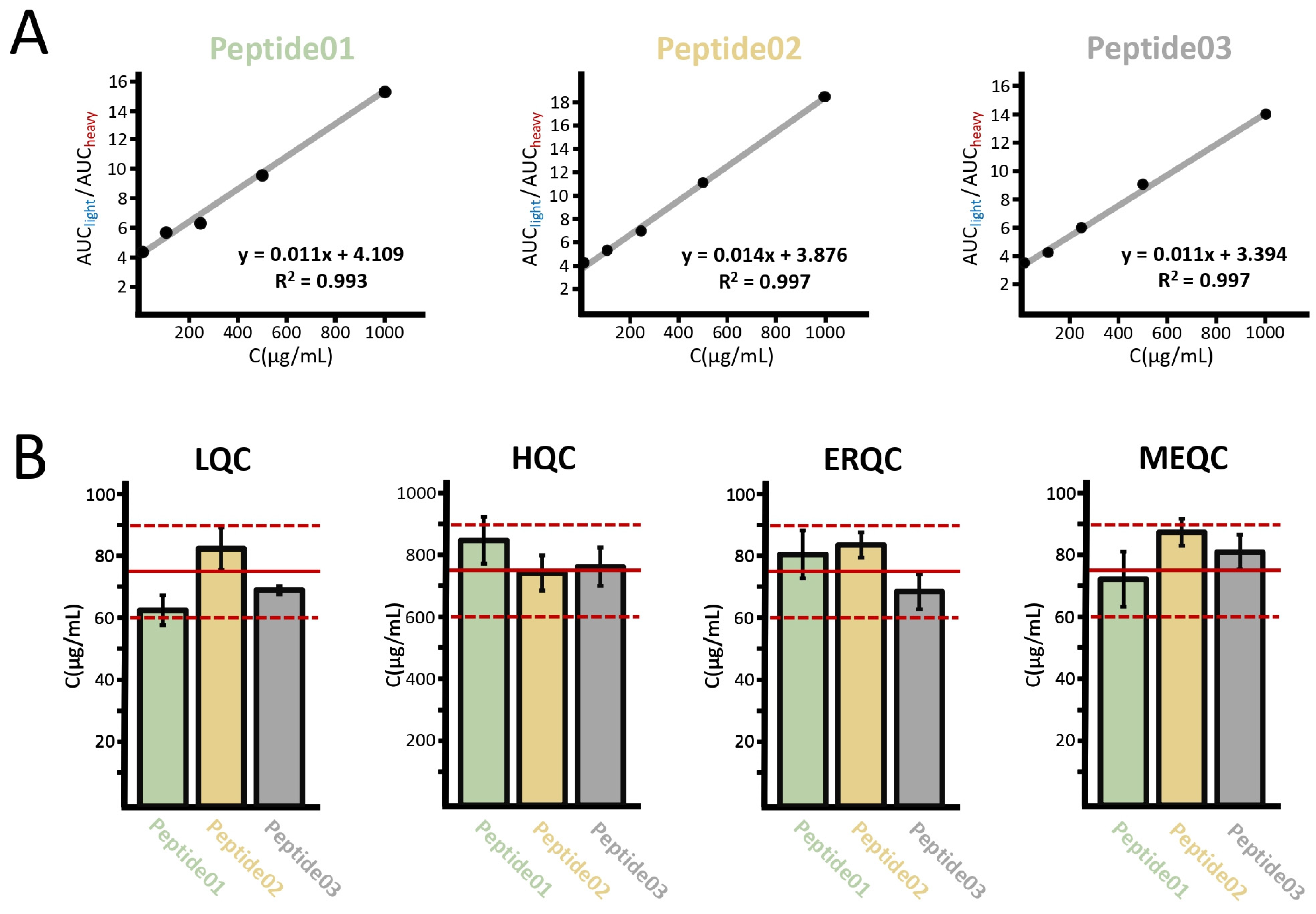
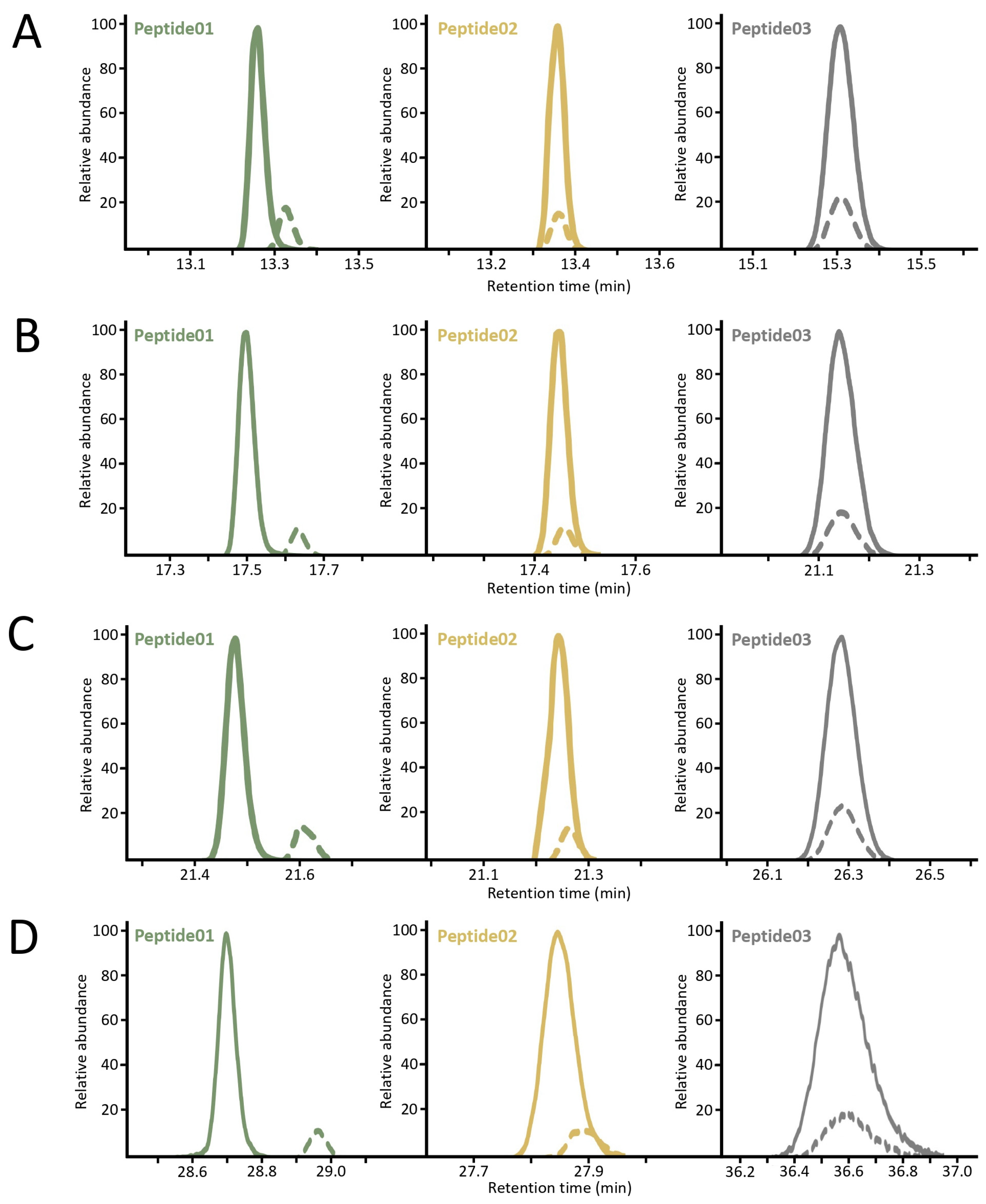
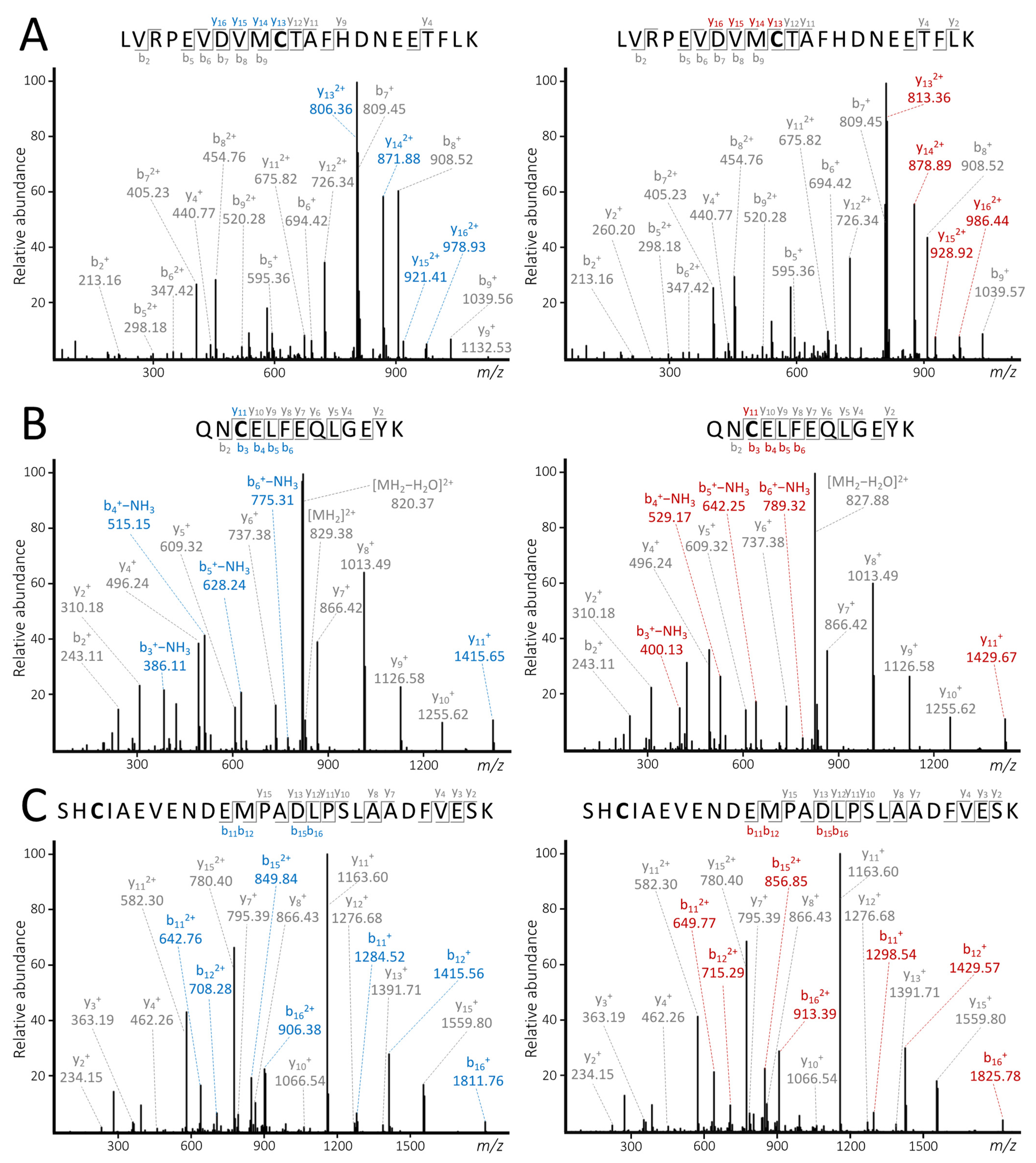
Disclaimer/Publisher’s Note: The statements, opinions and data contained in all publications are solely those of the individual author(s) and contributor(s) and not of MDPI and/or the editor(s). MDPI and/or the editor(s) disclaim responsibility for any injury to people or property resulting from any ideas, methods, instructions or products referred to in the content. |
© 2024 by the authors. Licensee MDPI, Basel, Switzerland. This article is an open access article distributed under the terms and conditions of the Creative Commons Attribution (CC BY) license (https://creativecommons.org/licenses/by/4.0/).
Share and Cite
Virág, D.; Schlosser, G.; Borbély, A.; Gellén, G.; Papp, D.; Kaleta, Z.; Dalmadi-Kiss, B.; Antal, I.; Ludányi, K. A Mass Spectrometry Strategy for Protein Quantification Based on the Differential Alkylation of Cysteines Using Iodoacetamide and Acrylamide. Int. J. Mol. Sci. 2024, 25, 4656. https://doi.org/10.3390/ijms25094656
Virág D, Schlosser G, Borbély A, Gellén G, Papp D, Kaleta Z, Dalmadi-Kiss B, Antal I, Ludányi K. A Mass Spectrometry Strategy for Protein Quantification Based on the Differential Alkylation of Cysteines Using Iodoacetamide and Acrylamide. International Journal of Molecular Sciences. 2024; 25(9):4656. https://doi.org/10.3390/ijms25094656
Chicago/Turabian StyleVirág, Dávid, Gitta Schlosser, Adina Borbély, Gabriella Gellén, Dávid Papp, Zoltán Kaleta, Borbála Dalmadi-Kiss, István Antal, and Krisztina Ludányi. 2024. "A Mass Spectrometry Strategy for Protein Quantification Based on the Differential Alkylation of Cysteines Using Iodoacetamide and Acrylamide" International Journal of Molecular Sciences 25, no. 9: 4656. https://doi.org/10.3390/ijms25094656
APA StyleVirág, D., Schlosser, G., Borbély, A., Gellén, G., Papp, D., Kaleta, Z., Dalmadi-Kiss, B., Antal, I., & Ludányi, K. (2024). A Mass Spectrometry Strategy for Protein Quantification Based on the Differential Alkylation of Cysteines Using Iodoacetamide and Acrylamide. International Journal of Molecular Sciences, 25(9), 4656. https://doi.org/10.3390/ijms25094656





